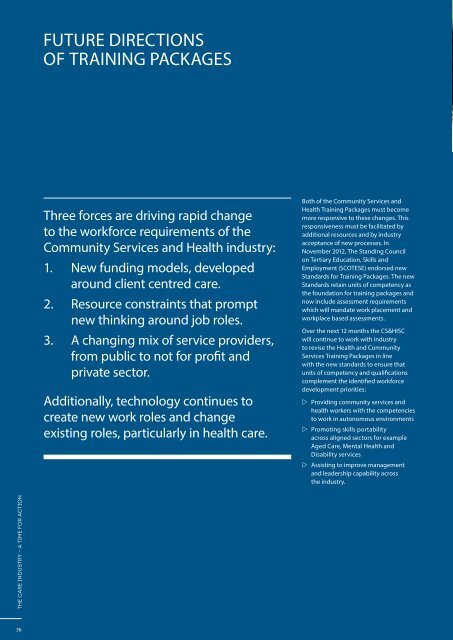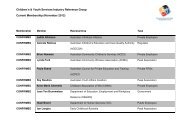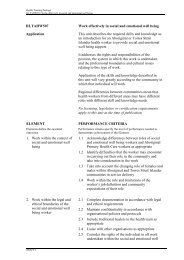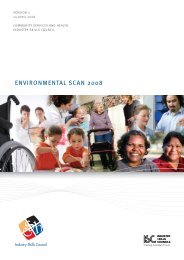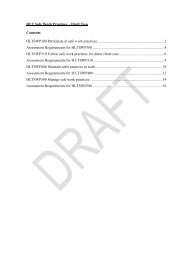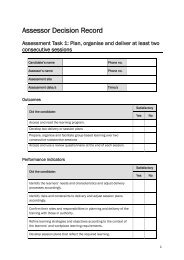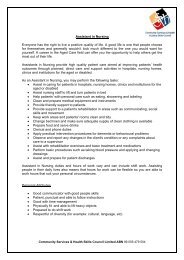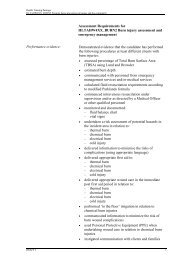2013 Environmental Scan - Community Services & Health Industry ...
2013 Environmental Scan - Community Services & Health Industry ...
2013 Environmental Scan - Community Services & Health Industry ...
Create successful ePaper yourself
Turn your PDF publications into a flip-book with our unique Google optimized e-Paper software.
FUTURE DIRECTIONS<br />
OF TRAINING PACKAGES<br />
THE CARE INDUSTRY – A TIME FOR ACTION<br />
Three forces are driving rapid change<br />
to the workforce requirements of the<br />
<strong>Community</strong> <strong>Services</strong> and <strong>Health</strong> industry:<br />
1. New funding models, developed<br />
around client centred care.<br />
2. Resource constraints that prompt<br />
new thinking around job roles.<br />
3. A changing mix of service providers,<br />
from public to not for profit and<br />
private sector.<br />
Additionally, technology continues to<br />
create new work roles and change<br />
existing roles, particularly in health care.<br />
Both of the <strong>Community</strong> <strong>Services</strong> and<br />
<strong>Health</strong> Training Packages must become<br />
more responsive to these changes. This<br />
responsiveness must be facilitated by<br />
additional resources and by industry<br />
acceptance of new processes. In<br />
November 2012, The Standing Council<br />
on Tertiary Education, Skills and<br />
Employment (SCOTESE) endorsed new<br />
Standards for Training Packages. The new<br />
Standards retain units of competency as<br />
the foundation for training packages and<br />
now include assessment requirements<br />
which will mandate work placement and<br />
workplace based assessments.<br />
Over the next 12 months the CS&HISC<br />
will continue to work with industry<br />
to revise the <strong>Health</strong> and <strong>Community</strong><br />
<strong>Services</strong> Training Packages in line<br />
with the new standards to ensure that<br />
units of competency and qualifications<br />
complement the identified workforce<br />
development priorities:<br />
ww<br />
Providing community services and<br />
health workers with the competencies<br />
to work in autonomous environments<br />
ww<br />
Promoting skills portability<br />
across aligned sectors for example<br />
Aged Care, Mental <strong>Health</strong> and<br />
Disability services<br />
ww<br />
Assisting to improve management<br />
and leadership capability across<br />
the industry.<br />
To respond, CS&HISC will:<br />
ww<br />
Increase the ‘speed to market’ for new<br />
training packages, units of competency<br />
and qualifications by working to<br />
shorten the implementation process<br />
Our success will be dependent upon<br />
agreement with key stakeholders and<br />
ensuring that appropriate industry<br />
consultations are undertaken and<br />
responsibilities for helping facilitate<br />
‘speed to market’ are shared quicker<br />
ww<br />
Reduce duplication in units of<br />
competency and promote common<br />
elements between aligned sectors<br />
ww<br />
Build the workforce development<br />
capacity of managers in the industry<br />
through recognised training and other<br />
forms of support.<br />
At the VET system level, meeting the<br />
workforce needs of the <strong>Community</strong><br />
<strong>Services</strong> and <strong>Health</strong> industry requires:<br />
ww<br />
Qualifications that are flexible and<br />
allow for the particular context of<br />
different workplaces<br />
ww<br />
Greater attention to the regulation of<br />
providers, especially around delivery<br />
of training and assessment<br />
ww<br />
Sustainable models for funding<br />
work placements<br />
ww<br />
Better pathways between VET<br />
and higher education and vice<br />
versa across all areas of<br />
community services and health.<br />
A QUICKER<br />
‘SPEED TO MARKET’<br />
The increasing pace of change in the<br />
industry means that the process for<br />
reviewing Training Packages and its<br />
endorsed components must be quicker<br />
and more streamlined than it has been<br />
in the past. A more efficient process<br />
and commitment to implementation from<br />
all stakeholders is required along with<br />
greater leadership to ensure quicker<br />
‘speed to market’ is achieved. Progress on<br />
implementation would also be facilitated by<br />
enhancing the capability and capacity of<br />
RTO’s to meet industry needs. The process<br />
for registration and accreditation also<br />
needs review to ensure they are optimised<br />
for greater ‘speed to market’.<br />
The mismatch between new workforce<br />
priorities and training package components<br />
is experienced across the different<br />
community services and health sectors<br />
and comes about because of time lags<br />
as well as changes to the policy settings<br />
beyond the VET system. Reducing the<br />
period spent developing and implementing<br />
new training packages, new units of<br />
competency and new qualifications will<br />
reduce this mismatch but will require a<br />
change in approach.<br />
To reduce the speed bumps CS&HISC<br />
will consider ways to increase ‘speed to<br />
market’ for the part of the process for<br />
which it has control. But it is clear this is<br />
only one part of the process and CS&HISC<br />
does not have sole responsibility for<br />
ensuring quicker ‘speed to market’.<br />
Getting national consensus across a range<br />
of stakeholders will require a strong policy<br />
direction and leadership beyond that<br />
which can be solely provided by CS&HISC.<br />
Greater traction would assist RTOs to<br />
develop quality curriculum products and<br />
hence respond to stakeholders’ needs in<br />
a timely manner. CS&HISC in pursuing<br />
the issue of quicker ‘speed to market’ is<br />
hopeful that this will generate action that<br />
leads to more market reflexive practices.<br />
DIRECTIONS FOR<br />
TRAINING PACKAGES<br />
The first workforce priority, providing<br />
workers with the competencies to work in<br />
client led care environments, is beginning<br />
to be addressed. Training Packages<br />
are being reviewed to ensure they are<br />
addressing issues of occupational health<br />
and safety, supervision, financial advice<br />
and legal obligations to clients including<br />
the inclusion of negotiation competencies<br />
as part of more generic skill sets.<br />
In relation to the second identified<br />
workforce priority, the CS&HISC will<br />
continue to work closely with stakeholders<br />
across the service sectors to develop<br />
a greater shared understanding and<br />
approach to aligning career pathways.<br />
CS&HISC is responding to this need in<br />
its current review and has established a<br />
consultation strategy to ensure consensus<br />
on the commonality across sectors.<br />
ENVIRONMENTAL SCAN <strong>2013</strong> : SECTION FOUR FUTURE DIRECTIONS OF TRAINING PACKAGES<br />
36<br />
37


